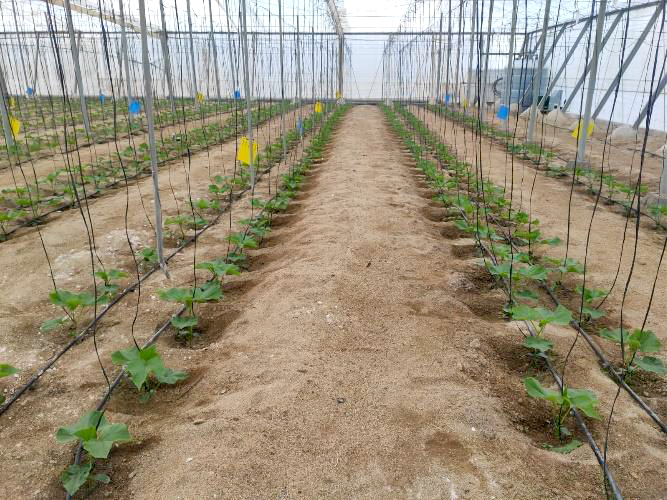BS Nature, a distributor of Moleaer’s nanobubble technology in Spain, together with Tecnova, a leading institution and research center in the agriculture sector in Spain, studied the effects of nanobubble-enriched irrigation water on cucumbers grown in a greenhouse with semi-controlled temperature and humidity conditions, under drip irrigation with fertigation.
A trial was conducted on two identically managed crops. The only difference was the injection of nanobubbles in the nutrient solution to compare with the control. During the trial, there were a few growth parameters measured, including plant height, phenological state of the crop, number of leaves, number of internodes and average distance between internodes, as well as roots color, weight, and length. Yield was measured by fresh weight and number of commercial and non-commercial fruit harvested. A foliar analysis was conducted at the end of the trial to characterize the organic matter, macro- and micro-nutrients content in the cucumber leaves.

The soil was imported with three different layers. Heavy imported soil, 30 cm in depth, was placed over the original soil of the Experimental Center. This was covered with a layer of manure, 3 cm in depth, and a final mulching layer of 10 cm of sand.
Nanobubble-enriched irrigation water yielded 8.8% higher commercial production compared to the control. The highest increase in the number of fruit was in the first harvest - 46 days after transplant - indicating more precocity, the measure of time to flowering within the lifespan of the crop, in the treatment with nanobubbles.

There was a higher level of Nitrogen (N) and Potassium (K) in the crop irrigated with nanobubble-enriched irrigation water, indicating a higher N and K uptake from the roots (confirmed by foliar analysis and decrease of nutrients in the soil). Similar results were found in other trials conducted by Cajamar at Las Palmerillas experimental station, where treatment with nanobubbles led to a higher accumulation of N and K in the fruit and a 16% increase in production.
The more efficient uptake of nutrients by the crop is is attributed to oxygen nanobubbles’ ability to mobilize nutrients in the soil and facilitate absorption by the root system. There was a very significant increase in root development resulting in a 45.4% increase in fresh weight in the crops irrigated with nanobubble-enriched irrigation water. This confirmed the beneficial effects of increased oxygenation in the root zone, fewer pathogens and better soil structure. No significant difference was observed regarding other parameters (crop height, number of internodes, number of developed leaves) although there was a slight difference in flavor of the nanobubble treatment in all three cases.

Moleaer’s nanobubble technology economically and efficiently supersaturates irrigation water with dissolved oxygen and injects hundreds of millions of electrochemically charged nanobubbles that alter the properties of water to deliver multiple benefits.

Increased dissolved oxygen levels maximize oxygen utilization by plants and beneficial microbes in the rhizosphere, promoting healthy root development and improving plants’ resilience to environmental stressors such as drought and heat.
High concentrations of negatively charged nanobubbles reduce the surface tension of water and improve the infiltration of soils as well as improve the capillary action of dissolved nutrients to get nutrients and water to the root zone where they are needed most.
Download Now